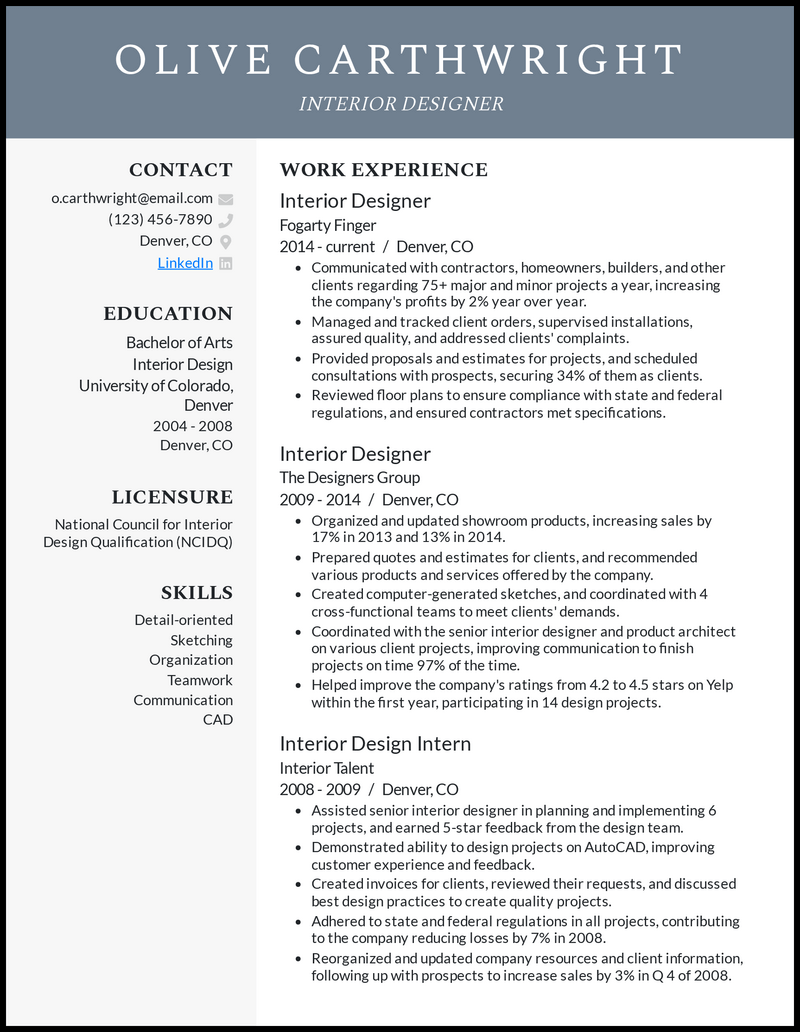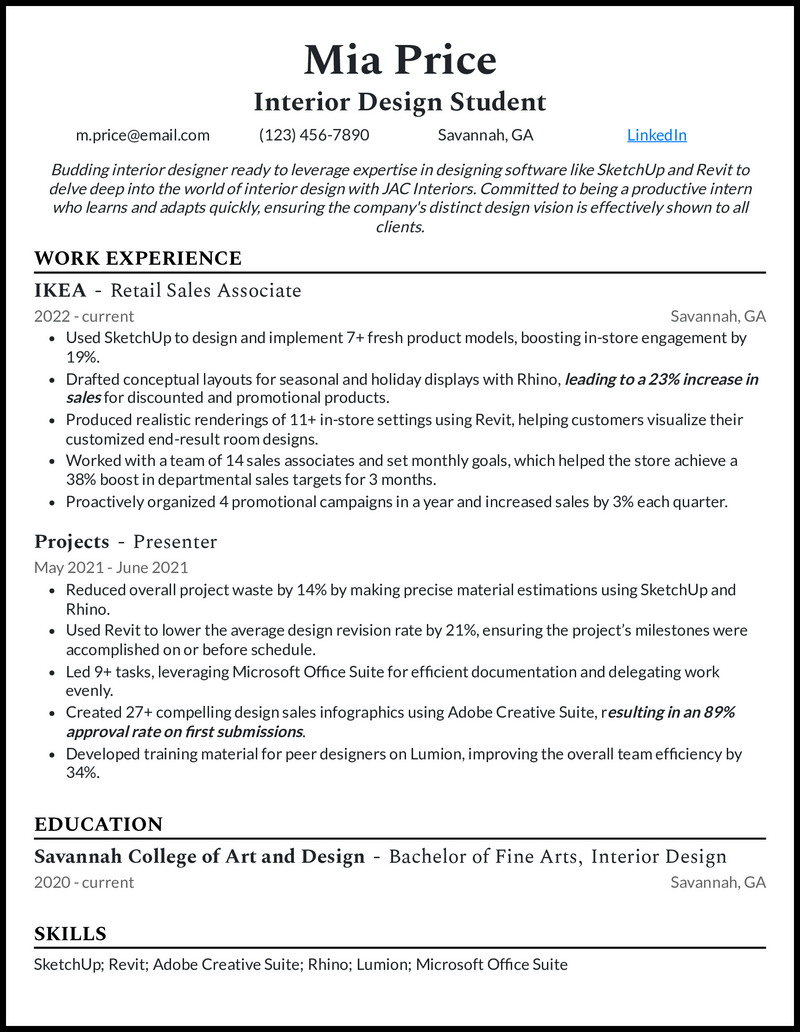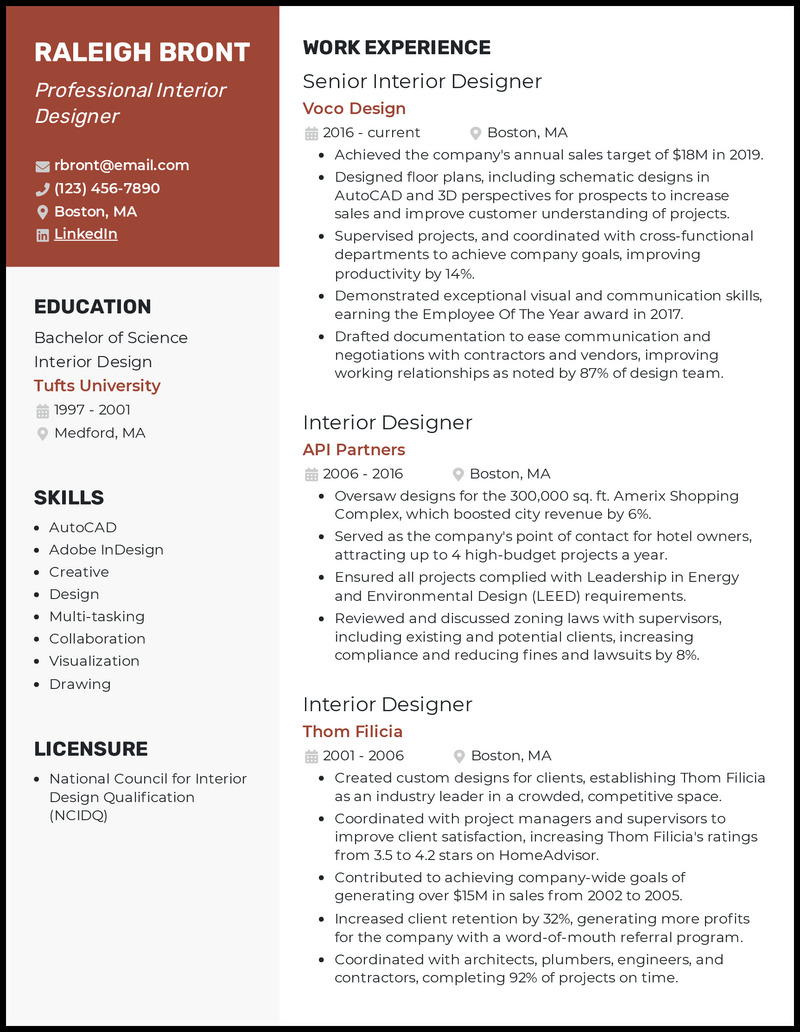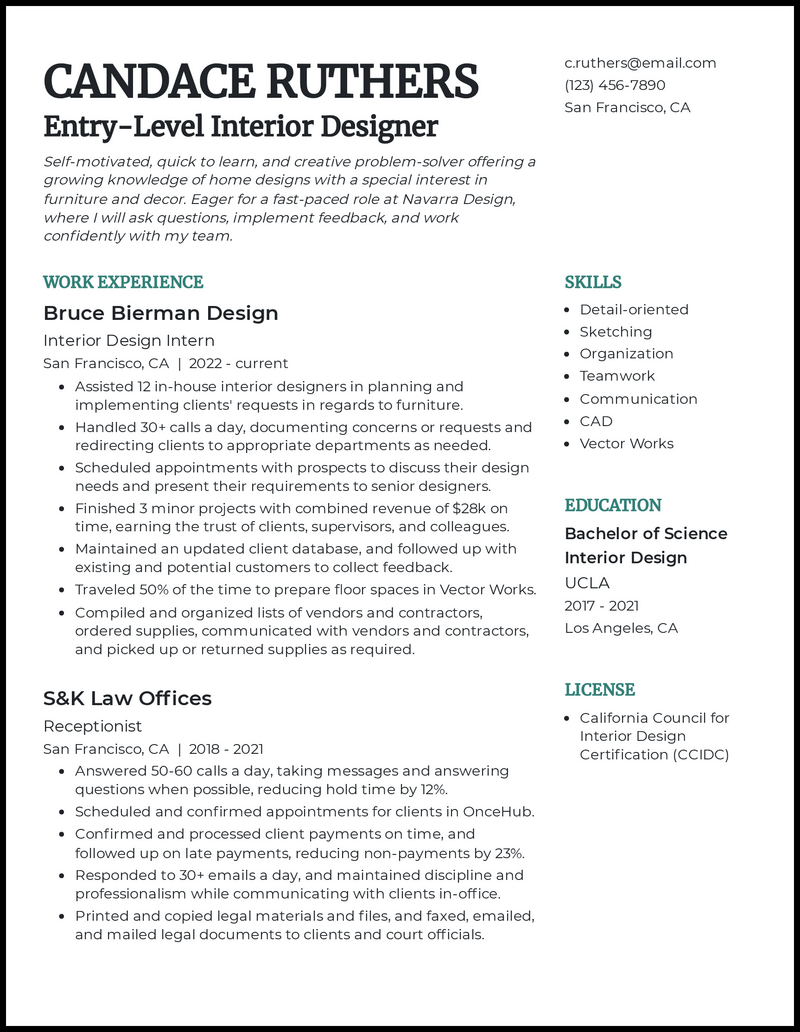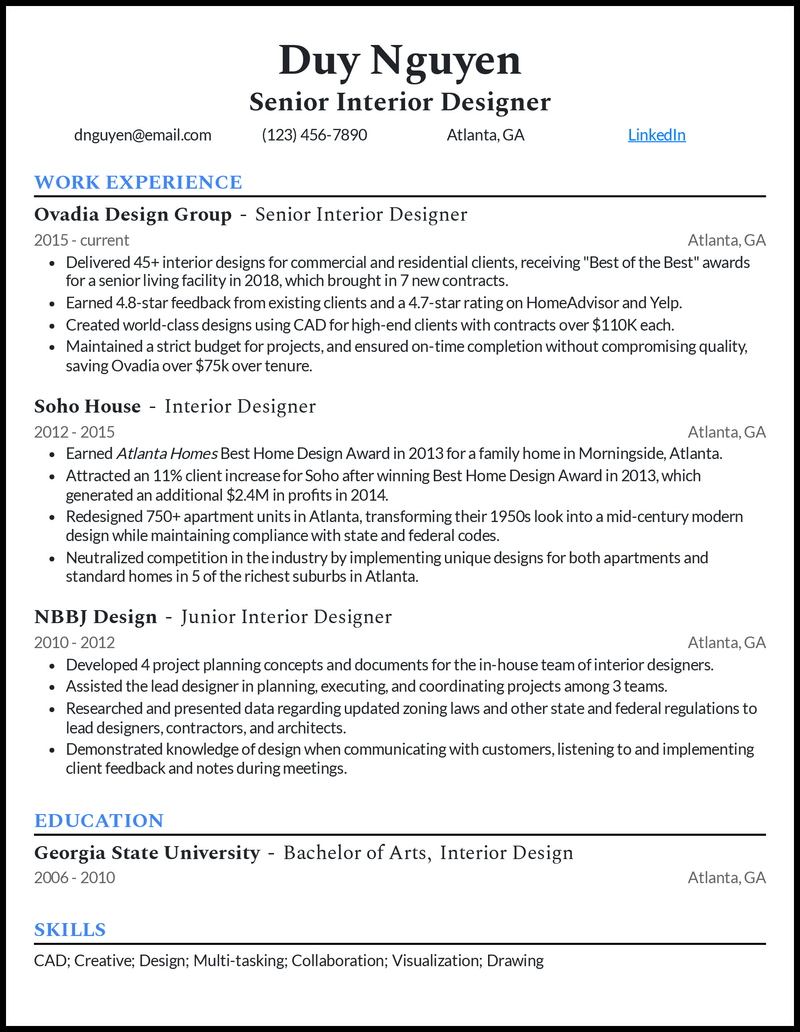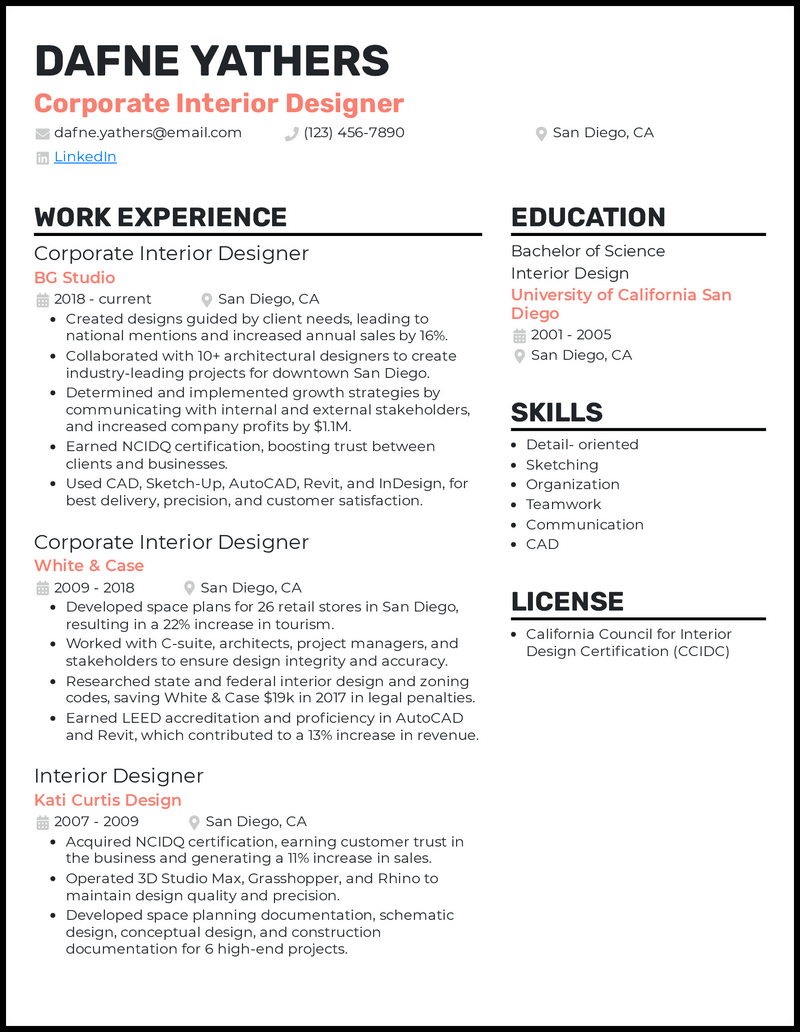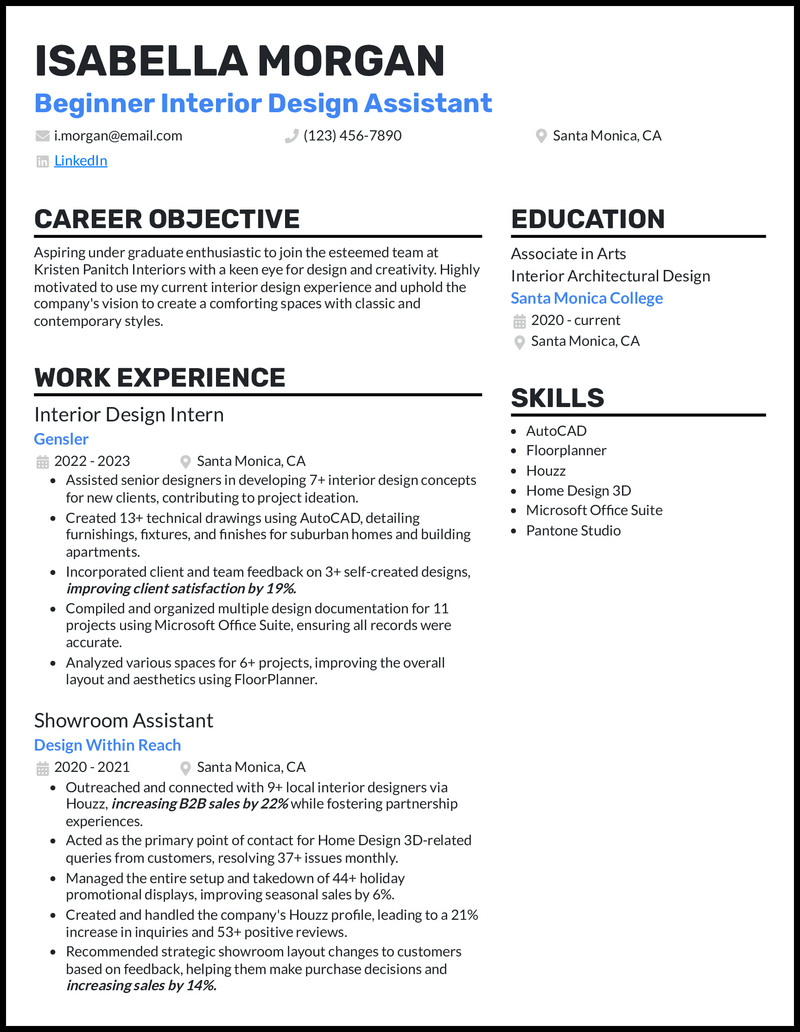Build an interior design resume showcasing your eye for detail with a clean format, top measurable results, and tools like AutoCAD or SketchUp.
Prove your worth with a portfolio of your work and industry recognitions. Remember to write a cover letter emphasizing your unique voice.
What you’ll find in this section:
- ↪ Tips for building a resume that reflects your design strengths
- ↪ What to include to showcase both technical and creative skills
- ↪ 7 interior design resume examples to guide and inspire you
Why this resume works
- Your interior design resume needs to list academic qualifications and industry-specific certifications.
- Create a separate section for your certifications or licenses, and don’t forget to mention which organization issued your license.
Why this resume works
- As a newcomer, you don’t need to have heavy metrics on your interior design student resume. In fact, at this stage, companies will mainly look for collaborative and creative skills.
- Don’t forget to mention how each design/layout helped solve a problem for the customers or company in your interior design cover letter.
Why this resume works
- No resume is ever going to be picture-perfect, but you want yours to be as close as possible! Fix your resume so you avoid:
- Grammar errors/typos/misspellings/missing information (especially contact information) and punctuation errors
Why this resume works
- If your entry-level interior design resume needs some more content, try adding a resume objective. This two-to-three-sentence statement sums up your skills and excitement for the job without taking up too much room.
See more entry-level interior design resumes >
Why this resume works
- Your senior interior design resume should be anything but boring, so use a resume template to add some artistic flair.
- You can also play with formatting options to include as much as possible while still keeping your resume readable and on one page.
See more senior interior design resumes>
Why this resume works
- If you’re not sure which technical skills to include on your corporate interior designer resume, start with the job description.
- Just remember that you should tailor your skills section for each position.
Why this resume works
- In a field with intense competition, your interior design no experience resume should contain experience that highlights your creativity and knowledge of using design software.
Related resume guides
How to Write an Interior Design Resume

When you write your interior design resume, don’t just list work and the tools you used. Instead, bring your stories to life by documenting the transformation of spaces, happy clients, recognitions, and featured works.
Summary
Captivate recruiters with a resume that reflects your creativity, showcases your technical chops, and positions you as the perfect interior design hire.
Craft a resume that earns you a spot at the interview table by highlighting key skills, achievements, and style that recruiters will want more of.
This section explores:
- Resume formatting to reflect your design style and professionalism
- What to include to highlight both creative and technical skills
- Ways to showcase your portfolio, certifications, and client experience
- Tips for writing a short, effective career summary that sets the tone
But before we begin, explore these resume examples for inspiration.
Ready? Let’s dive in.

Decide on resume format
The reverse chronological order will capture the juices from your successful career. It starts with the most recent experiences and goes back to where you started, clearly showcasing your professional growth. This layout is easy to scan for applicant tracking systems (ATS) and human recruiters to find your strengths quickly.
What the proper format entails:
- Enough white space.
- Clear headings
- Impactful bullet points
- Consistent font types and sizes
- Enough white space

Craft an outstanding header
A messy header means you’re starting at a disadvantage. No matter how qualified you may be, recruiters won’t be digging through your contact information to find an email or your phone number.
Ensure your resume header is professional, visible, accurate, up to date, and includes the following:
- First and last name
- The specific job title
- Professional email address
- Personal phone number
- City & state (if the job is out of your state, say you’re willing to relocate)
- LinkedIn URL (complete with an updated LinkedIn summary and profile)
- Portfolio URL (it’s important to have one)

Summarize your qualifications
You’ll need a resume summary if you’re a seasoned interior designer. For beginners and career switchers, go with a career objective.
With a professional profile, recruiters can instantly see your potential even before reading the rest of the details.
When summarizing your qualifications, stick to 2-3 compelling lines that discuss your experience, skills, top achievement, job title, and how you fit into the company’s needs.
Example of a summary
Transformed 100+ residential and commercial spaces across Los Angeles in over 12 years, blending sustainable design with client-centric concepts. Expertise in project leadership, FF&E sourcing, AutoCAD, and Revit. Committed to telling stories by creating functional spaces.
Example of a objective:


Know the responsibilities that await you
What are the responsibilities of a graphic designer as per the job posting? If you can answer this question, you’ll easily align your resume to your future employer’s expectations.
Some of your routines will be:
- Meet and assess clients’ design needs
- Create and pitch design models
- Select design elements, such as materials and color schemes
- Manage project timelines and budgets
- Communicate with vendors and contractors
- Adhere to compliance and safety codes
- Present concepts and final products
Pro tip: The next thing to do is ensure your application mirrors those tasks and boost your chances of landing an interview.

Showcase your impactful interior design work experience
Your work experience should be like a reel of what you’ve done and proof of your accomplishments. Use the STAR approach: Present a Situation, highlight a Task, show Action, and demonstrate a measurable Result.
Remember, it’s all about showing, not telling, what you did. To highlight the impact of your past roles, use numbers and active verbs to generate bullet points that showcase a career full of accomplishments.

Work experience for interior design with no experience resume
Lack of experience shouldn’t dim your hopes of getting an interior design job. You must be strategic and use your passion, education, projects, internships, apprenticeships, and volunteer work to inform hiring managers about your potential. Show what you did, the tools used, and the results from each activity.
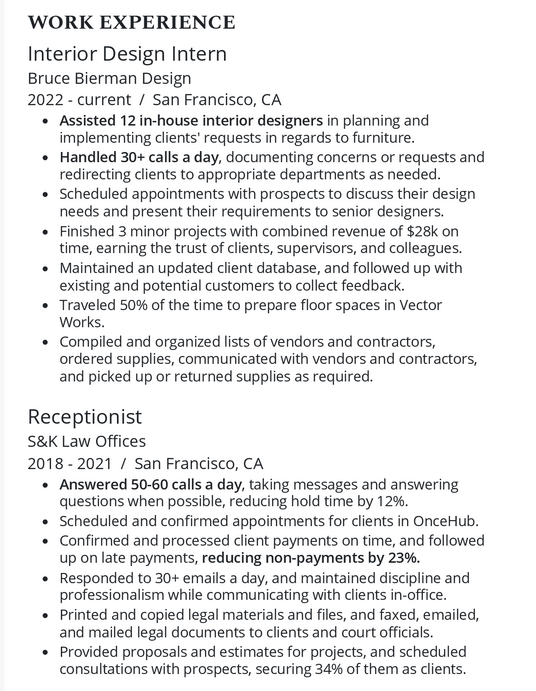

Highlight interior design competencies
ATS will scan your technical skills before passing your resume to an HR manager. You should include some of these competencies listed in the job advert. This approach helps you align with the role and stand out to recruiters.
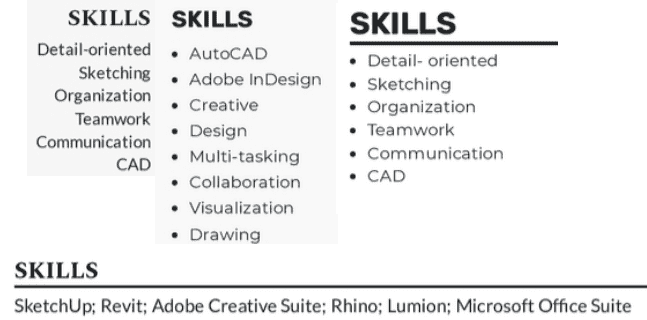

Demonstrate key soft skills
First, you’re a designer before anything else. However, your job expects you to be a project supervisor, a team worker, a time manager, and a communicator. This is the right time to bring out your soft skills, including:
- Time management
- Excellent stakeholders’ communication
- Critical thinking
- Creativity
- Adaptability
- Problem-solving
- Time management

Add relevant education and licences
Education and relevant licensure prove your professionalism and knowledge of design principles. They also show that you have the patience, adaptability, and attitude to learn and implement the best design practices in a real-world project.
When you list your education, include the title of your area of study, the name of the institution, the location, and the graduation year.
For certification, provide the accreditation’s name, issuing body, and expiry date (if applicable).
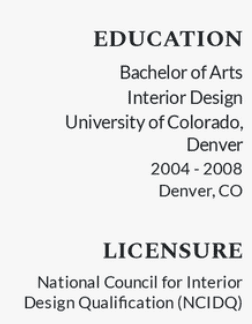

Bonus sections: awards, volunteer work, membership in professional bodies
In this dynamic and competitive field, you must be creative to be better than your competition. Including extra sections that demonstrate your unique abilities can make you stand out.
You can include things such as:
- Design competition wins, such as AIA and class projects
- Voluntary work in community centers
- Memberships to bodies such as NCIDQ and ASID

Customize your resume for the role
Every job is different, and you should customize your resume to reflect employers’ wishes. When you tailor your application, hiring managers consider you an excellent communicator, intentional, and a professional.
Here’s how you can do that effectively:
- Adapt the tone of the job posting
- Emphasize technical skills
- Share a portfolio
- Use keywords from the job advert

Key takeaways
What did you learn here?
- Keep your resume clean, modern, and visually balanced—let the layout speak to your design sense
- Highlight real-world results, not just tasks—show how your work made a difference
- Tailor each resume to the role by matching keywords and tools mentioned in the job post
- Include a portfolio link that’s easy to find and opens without friction
- Use your summary to position yourself quickly and set the tone for the rest
- Don’t forget the details: file format, readable fonts, and no typos—ever
Average Annual Salaries for Interior Designers in the US
While you can work as an independent contractor and earn on a project-by-project basis, you can also land a permanent role in a company. Below is what you can expect as your mean average salary according to the US Bureau of Labor Statistics update of 5/1/24.
| National/State | Average annual salary ($) |
|---|---|
| National | $71,430 |
| Maryland | $74,410 |
| New Jersey | $75,040 |
| Vermont | $75,440 |
| Illinois | $76,400 |
| New York | $77,170 |
| Wisconsin | $78,580 |
| Washington | $81,030 |
| Massachusetts | $82,040 |
| California | $85,650 |
| District of Columbia | $90,960 |
Interior Design Resume FAQs

It’s a collection of past job projects, responsibilities, and achievements. It’s what you use to tell the next potential employer about your past wins and that you can thrive in their company’s open position. To make the most out of your work history, don’t list tasks but showcase the impact with measurable results.
One page. You’re a designer who uses your work to turn spaces into spectacular views. Use the same approach when writing your resume, emphasizing your skills and impactful outcomes. You won’t need more than a page to convince prospective employers of your abilities. The only exception to going beyond a page is when you have a lot of experience and an impressive list of top accomplishments. Even then, ensure you only include the most valuable details.
Projects, internships, voluntary work, strong education background, relevant courses, competitions won, etc. Since you don’t have much experience, use these activities to give a taste of your potential and what you can bring to the role. Also, let recruiters notice your passion and knowledge of relevant tools and software.
Give a tale of your accomplishments. Careful not to talk about your responsibilities because employers don’t care about that much. Highlight your proper use of pertinent skills to get impressive results for past employers and clients. With a consistent track of wins, any recruiter can tell you deserve the job.
Land your next job with our AI-powered, user-friendly tool.
Gut the guesswork in your job hunt. Upload your existing resume to check your score and make improvements. Build a resume with one of our eye-catching, recruiter-friendly templates.
• Work in real-time with immediate feedback and tips from our AI-powered experience.
• Leverage thousands of pre-written, job-specific bullet points.
• Edit your resume in-line like a Google Doc or let us walk you through each section at a time.
• Enjoy peace of mind with our money-back guarantee and 5-star customer support.




